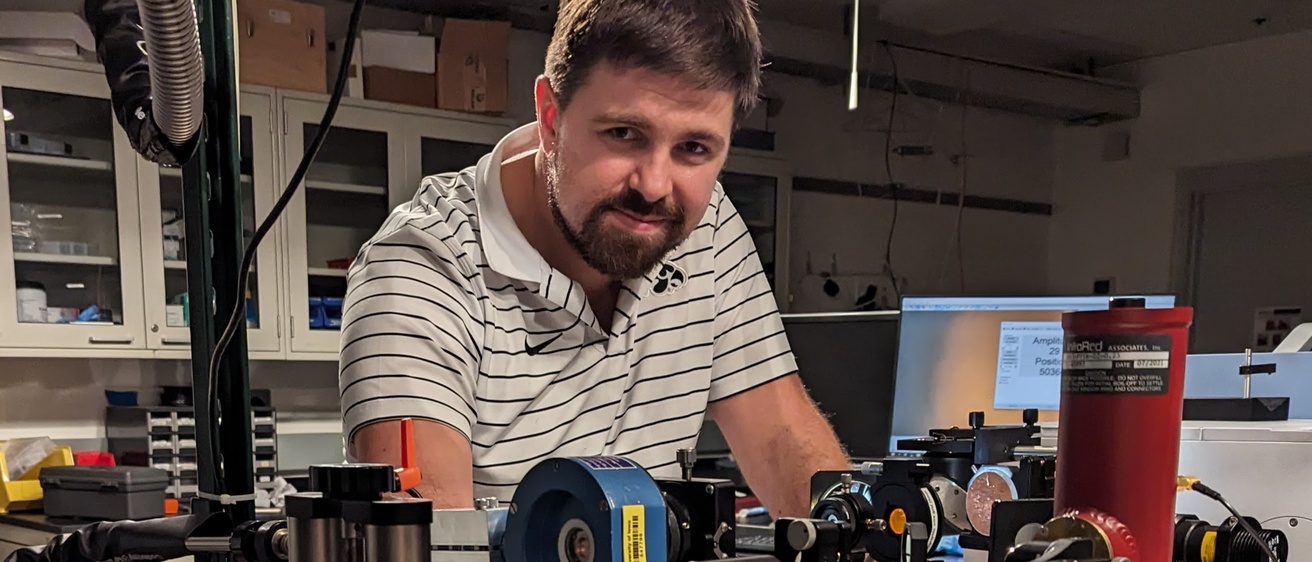Tom Folland, an assistant professor in the Department of Physics and Astronomy in the College of Liberal Arts and Sciences, has earned five grants totaling more than $2.8 million to help advance his research in condensed matter and materials physics.
“I was delighted to win these awards,” Folland says. “I was quite shocked at so many grants coming within the year. While some of this is luck, I think this can be attributed to my group’s growth over the past couple of years.”
Read on for more details about each of Folland's five awards.
“CAREER: Photonics in the Lowest Symmetry Crystals”
In March, Folland received a prestigious National Science Foundation CAREER Award titled, “CAREER: Photonics in the Lowest Symmetry Crystals.” The award carries $604,691. The research focuses on how certain classes of crystals can be used to control both the orientation and direction of light waves. As a result of this, key advances can be made in the creation of optical technologies such as quantum optics, laser imaging, and more.
In April, Folland received a five-year grant from the Office of Naval Research’s Multidisciplinary University Research Initiative. The grant provides up to $1.5 million annually and is run by Vanderbilt University’s Josh Caldwell — it is also shared by the University of Minnesota and Stanford University. The funds will be put toward the study of twist optics—the interaction of two stacked crystals and the unique properties that result from their combination; this will allow for the better prediction of emergent properties created by the crystals.
In June, Folland received a $235,000 grant from the University of Iowa Office of the Vice President for Research for the development of a quantum sensor that would detect polyfluoroalkyl substances (PFAS) and hydrogen molecules. The sensor and its ability to detect hydrogen molecules and PFAS is of the utmost importance, as asserted by current federal administrations; the detection of hydrogen leaks is significant for the evolving hydrogen economy, and PFAS molecules, also known as forever chemicals, are known to build up in the human body and cause a variety of health issues.
"Phonon Polariton Based Infrared Optoelectronics”
In July, both Folland and Professor John Prineas received $411,378 in a second grant from the National Science Foundation, this one for the development of long wavelength infrared light detectors with the ability to measure atmospheric chemicals. These detectors allow scientists to complete such tasks as non-contact temperature imaging, detecting chemical changes in the atmosphere, and more.
Folland’s most recent grant comes once again from the Office of Naval Research, this time providing $434,814 for the development of nano-optic infrared probes. The project intends to demonstrate the importance and potential of infrared probes for the imaging and quantification of electrical, optical, and phonon behaviors of wide band gap semiconductors.
Folland, who has been part of the faculty in College of Liberal Arts and Sciences for three years, says that the University of Iowa has provided him with the facilities and resources necessary for the accomplishment of these grants. With these achievements, alongside the continued support of the university and college, Folland is confident in his ability to continue to expand his research and continue to pursue ambitious goals.
“I think it’s an exciting time to be at Iowa,” Folland finishes. “I expect more exciting growth in this area from my colleagues over the next few years.”
By Charlotte Brookins, CLAS Communications
